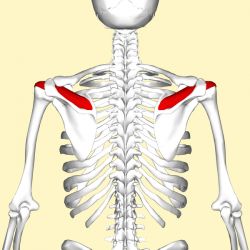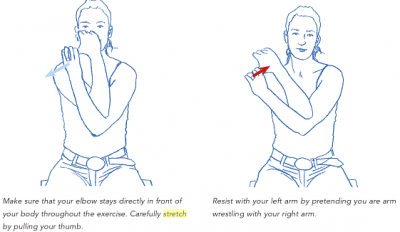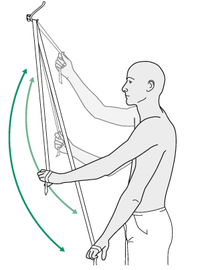Definition/Description
A supraspinatus tear is a tear or rupture of the tendon of the supraspinatus muscle. The supraspinatus is part of the rotator cuff of the shoulder. Most of the time it is accompanied with another rotator cuff muscle tear. This can occur in due to a trauma or repeated micro-trauma and present as a partial or full thickness tear.[1] Most of the time the tear occurs in the tendon or as an avulsion from the greater tuberosity.[2]
Clinical relevant anatomy
The shoulder joint is made up of three bones: the humerus, scapula and clavicle. The head of humerus and glenoid of the scapula form a ball-and-socket joint[1]. The supraspinatus muscle is located on the back of the shoulder, forming part of the rotator cuff. The rotator cuff consists of Supraspinatus, Infraspinatus, Subscapularis and teres minor. The rotator cuff covers the head of the humerus and keeps it into place. These muscles help to lift and rotate the arm. Also see the page for the shoulder for more detailed information.
Supraspinatus
- Origin: Supraspinous fossa of the scapula
- Insertion: Greater tubercle of the humerus
- Innervation: Supraspinatus nerve (C5-C6)
- Function: Abduction of the glenohumeral joint; assists the rotator cuff in stabilizing, control and movement the shoulder; assists in preventing sublaxation at the shoulder
Epidemiology/Etiology
The etiology of supraspinatus tears is multifactorial, consisting of age-related degeneration, microtrauma and macrotrauma. The incidence increases with the age to about 50% during the 80s, mostly affecting the dominant arm.[5][6]Injury and degeneration are the two main causes of rotator cuff tears. Rotator cuff tears are associated with older patients, a history of trauma and mostly affect the dominant arm. The most common risk factors for a tear consist of a history of trauma, dominant arm and age.
Mechanism of injury
- Acute tear: Can occur with other shoulder injuries (e.g. clavicle fracture of shoulder dislocation)
- Fall on your outstretched arm
- Heavy lifting something too heavy
- Degenerative: Wear and tear of the tendon slowly over time
- Increases with the age
- More common in the dominant arm
- When you have a degenerative tear in one shoulder, you have a greater risk for a tear in the opposite shoulder, even if you have no pain in the opposite shoulder.
Risk factors
- > 40 years old
- Male > Female
- Smoking
- Genetics
- Hypercholesterolemia
- Body mass index
- Height
- Repetitive stress/lifting
- History of trauma
- Lack of blood supply
- Bony spurs
- Overhead activities and other people who do overhead work:
- Tennis players
- Baseball pitchers
- Painters
- Carpenters
- Plumbers
- Traumatic injury e.g. fall (more common cause in younger individuals)
Characteristics/Clinical presentation
Supraspinatus tears normally present as partial or full-thickness tears. The can be asymptomatic or symptomatic.
- Partial thickness: Incomplete disruption of muscle fibers[1]
- Can progress to complete tear – Increasing pain is normally the first sign of progression of a tear
- Full thickness: Complete disruption of muscle ibers
- Large tears (1-1,5cm) have high rate of progression
- If progression is suspected in conservatively managed cases – further investigation is warranted
- Smaller tears (
Signs & symptoms
Patients normally present with:[1][6][7]
- Pain/worsening pain (in cases where tears are progressing): Most common symptom
- Pain when lifting and lowering your arm or with specific movemen
- Pain at rest
- Pain at night, predominantly when you lie on the affected shoulder
- Traumatic tears: Sudden, intense pain often accompanied by a snapping sensation and immediate weakness in the upper arm
- Located anterolaterally and superiorly
- Referred to the level of the deltoid insertion with full-thickness tears
- Repetitive strain tear: Starts off mild and only when lifting your arm; over time the pain can become more noticeable at rest
- Aggravated in overhead or forward-flexed position
- Limited range of motion:
- Reduced forward elevation, external rotation and abduction
- Struggle with activities like reaching behind back, combing hair and overhead activities
- Weakness when rotating or lifting your arm
- Crepitus
- Clicking
- Stiffness
- Limited range of motion:
- Reduced forward elevation, external rotation and abduction
- Struggle with activities like reaching behind back, combing hair and overhead activities
- Instability
Differential diagnosis
Diagnostic procedures
Physical examination
- Subjective interview:
- Onset: Spontaneous or after injury
- Duration of pain
- Pain provocation/aggravating factors
- Night rest
- Same problems in the past?
- Activity limitations
- Localize pain
- Past medical history
- Recreational or sport activities (possible overhead activities)
- Observation:
- Range of motion:
- Expect reductions in flexion, abduction and external rotation
- If passive abduction range is more than active range, it is an indication of a rotator cuff tear
- Muscle power:
- Test supraspinatus by resisting abduction at 90° and internal rotation
- Scapular movement may be affected
- Palpation: Forearm behind back to palpate rotator cuff just anterior and below the acromion
- Muscle atrophy present
- Tenderness
- Special tests:
- Drop-arm test: Active shoulder abduction to 90°, then return [10]
- Positive: Dropping the arm down with pain indicates a positive test
- Drop-arm test: Active shoulder abduction to 90°, then return [10]
-
- Jobe/supraspinatus/empty can test: Resist shoulder abduction and internal rotation[10]
-
- Full can test: Resisted shoulder abduction in external rotation
-
- Subacromial grind test: Patient standing and examiner standing facing the patient, the examiner grasps the patient’s flexed elbow. The shoulder is passively abducted in the scapular plane to 90°. The examiner’s other hand is placed over the patient’s shoulder overlying the anterior acromion and greater tuberosity. The examiner passively internally and externally rotates the shoulder detecting the presence of palpable crepitus.
- Positive: Palpable crepitus.[11]
- Subacromial grind test: Patient standing and examiner standing facing the patient, the examiner grasps the patient’s flexed elbow. The shoulder is passively abducted in the scapular plane to 90°. The examiner’s other hand is placed over the patient’s shoulder overlying the anterior acromion and greater tuberosity. The examiner passively internally and externally rotates the shoulder detecting the presence of palpable crepitus.
Special investigations
- X-rays:
- Exclude sclerosis and osteophyte formation on the acromion
- Measure the size of the subacromial space
- Unable to see tendon
- MRI: Shows partial or full tears in the tendons of the rotator cuff, inflammation to weak structures and cracks in the capsule
- CT scan: Able to localize tendon when patient positioned with forearm behind back
- Ultrasound: Able to localize tendon
Outcome measures
Medical management
Conservative management
- Older (>70 years) patients with chronic tear
- Patients with irreparable tears with irreversible changes
- Patients of any age with small (
- As a result of the slow rate of progression of these tears
Management include:[14]
- NSAID’s:
- Ibuprofen
- Corticosteroid injections:
- Eliminate pain for a period of time, making physiotherapy management easier
- Tendon tissue can be weakened by these injections (which would have an adverse effect on the outcome of a possible surgery)
- Limited to 2 injections
- Physiotherapy (see Physiotherapy management below)
Surgical management
- Failed conservative management
- Larger symptomatic full-thickness tears ( 1-1,5cm) as a result of the high rate of progression
- Should be considered for earlier surgical repair in younger patients if the tear is repairable and the muscle degeneration is limited
- Acute large tears (>1 cm-1.5 cm) or
- Young patients with full-thickness tears who have a significant risk for the development of irreparable rotator cuff changes
- Complete tear with significant pain and dysfuction after 6 months of treatment
- Repeated dislocations
Surgery: Rotator cuff repair[15]
- Mostly done arthroscopically
- Severity (partial vs full-thickness) will determine approach
- Partial repair:[16]
- The tendon and surrounding bone will be smoothed to avoid further damage and therefor allowing the tendon to heal mostly on its own
- Complete tear:[17]
- Tear in middle of tendon: Suture the two parts of the tendon back together.
- Tear close or on its point of attachment on the head of the humerus: Attach the tendon back to its original place by an anchor (sometimes two). This anchor actually consists of a small screw that is bored into the head of the humerus with on the back surgical wires which hold the tendon in place.
Physiotherapy management
Physiotherapy management depends on the extend of the tear, and plays in important role in both conservative management as well as post-surgical rehabilitation. More details can also be obtained from the rotator cuff page.
Conservative management
Physiotherapy goals:
- Improve pain together with NSAID’s (2-6 weeks)
- Cryotherapy (only in first 48 hours)
- Massage
- Improve circulation (to control inflammation and speed up the healing process)
- Improve range of motion:
- Stretching (careful with timing, as stretching of acute injury may aggravate the tear):[18]
- Crossover arm stretch: 12 seconds, 5 times a day; 5-6days/week
- Stretching (careful with timing, as stretching of acute injury may aggravate the tear):[18]
Kristian Berg. Prescriptive stretching; Human Kinetics [19]
- Door stretch: 5 x 30 seconds (5 second rest in between)
- Passive/Active range of motion:[20]
- Pendulum exercises: Forward and back, side-to-side, circular motion. 2 sets of 10 a day, 5-6days/week
- Symptom limited active-assisted range of motion exercises
Kristian Berg. Prescriptive stretching; Human Kinetics [19]
- Increase strength:[21][22]
- Rotator cuff (especially supraspinatus) strengthening to improve muscle control and strength – 13,19
- Prone Horizontal Abduction progress by using theraband
- Prone Row with External Rotation
- Regain function of affected upper limb (up to 3 months)
- Home exercise programme
Resources
Clinical bottom line
A supraspinatus tear can occur in due to a trauma or repeated micro-trauma and present as a partial or full thickness tear.[1] Most of the time the tear occurs in the tendon or as an avulsion from the greater tuberosity[2]. The tear can be partial or full-thickness. Pain, loss of range of motion and weakness is the 3 most common symptoms.[1][6][7] Supraspinatus tears can be managed conservatively, with NSAID’s and physiotherapy, as well as surgically to repair the tear.
References
- ↑ 1.01.11.21.31.41.51.61.71.8 American Academy of Orthopedic Surgeons, Ortho Info. Rotator cuff tears, http://orthoinfo.aaos.org/topic.cfm?topic=a00064 (accessed 29/08/2018).
- ↑ 2.02.1 Benazzo F, Marullo M, Pietrobono L. Supraspinatus rupture at the musculotendinous junction in a young woman. Journal of Orthopaedics and Traumatology 2014;15(3):231-4.
- ↑ Schünke M, Schulte E, Schumacher U, Voll M, Wesker K. Prometheus: Algemene anatomie en bewegingsapparaat, 2010. p600.
- ↑ Physioworks, Rotator Cuff Tear.http://physioworks.com.au/injuries-conditions-1/rotator-cuff-tears (accessed 29/08/2018).
- ↑ 5.05.15.25.3 Tashjian RZ. Epidemiology, natural history and indications for treatment of rotator cuff tears. Clinics in Sports Medicine 2012:31(4):589-604.
- ↑ 6.06.16.26.36.46.5 Yamamoto A, Takagishi K, Osawa T, Yanagawa T, Nakajima D, Shitara H, Kobayashi T. Prevalence and risk factors of a rotator cuff tear in the general population. Journal of shoulder and elbow surgery 2010:19(1):116-20.
- ↑ 7.07.1 Mayo Clini Rotator cuff injury. http://www.mayoclinic.org/diseases-conditions/rotator-cuff-injury/symptoms-causes/dxc-20126923 (accessed 30/08/2018).
- ↑ Medscape. Supraspinatus tendonitis: Differential diagnoses, http://emedicine.medscape.com/article/93095-differential (Accessed 20/03/2015).
- ↑ Medscape. Rotator cuff injury: Differential diagnoses, http://emedicine.medscape.com/article/92814-differential, (Accessed 25/03/2015).
- ↑ 10.010.1 Hughers PC, Taylor NF, Green RA. Most clinical tests cannot accurately diagnose rotator cuff pathology: a systematic review. Aust J Physiother 2008;54(3):159-70.
- ↑ Sawalha S, Fischer J. The accuracy of “subacromial grind test” in diagnosis of supraspinatus rotator cuff tears. International journal of shoulder surgery 2015;9(2):43-46.
- ↑ Walters J, editor. Orthopaedics – A guide for practitioners. 4th Edition. Cape Town: University of Cape Town, 2010.
- ↑ Orthop J. Rotator cuff tear: physical examination and conservative treatment. Department of Orthopaedic Surgery Tohoku University, 2013:197–204.
- ↑ Björkenheim JM, Paavolainen P, Ahovuo J, Slätis P. Surgical repair of the rotator cuff and surrounding tissues. Factors influencing the results. Clinical orthopaedics and related research 1988;(236):148-53.
- ↑ 15.015.1 Millar NL, Wu X, Tantau R, Silverstone E, Murrell GA. Open versus two forms of arthroscopic rotator cuff repair. Clinical orthopaedics and related research 2009;467(4):966-78.
- ↑ American Academy of Orthopedic Surgeons. Rotator Cuff Tears: Surgical Treatment Options. https://orthoinfo.aaos.org/en/treatment/rotator-cuff-tears-surgical-treatment-options/ (accessed 30/08/2018).
- ↑ Akpınar S, Uysal M, Pourbagher MA, Ozalay M, Cesur N, Hersekli MA. Prospective evaluation of the functional and anatomical results of arthroscopic repair in small and medium-sized full-thickness tears of the supraspinatus tendon. Acta orthopaedica et traumatologica turcica 2011;45(4):248-53.
- ↑ Kuhn JE. Exercise in the treatment of rotator cuff impingement: a systematic review and a synthesized evidence-based rehabilitation protocol. Journal of shoulder and elbow surgery 2009;18(1):138-60.
- ↑ 19.019.1 Kristian Berg, Human Kinetics:. Prescriptive stretching. 2011.
- ↑ Joseph Berman MD. Supraspinatus tear, http://www.josephbermanmd.com/diagnosis-treatament-of-the-shoulder/rotator-cuff-tear/ (accessed 29/04/2015).
- ↑ Physioroom. Exercises to Strengthen the Rotator Cuff Muscles in the Shoulder.http://www.physioroom.com/experts/asktheexperts/answers/qa_mb_20050225.php (accessed 31/08/2018).
- ↑ Heers G, Anders S, Werther M, Lerch K, Hedtmann A, Grifka J. Efficacy of home exercises for symptomatic rotator cuff tears in correlation to the size of the defect. Sportverletzung Sportschaden: Organ der Gesellschaft fur Orthopadisch-Traumatologische Sportmedizin 2005;19(1):22-7.



